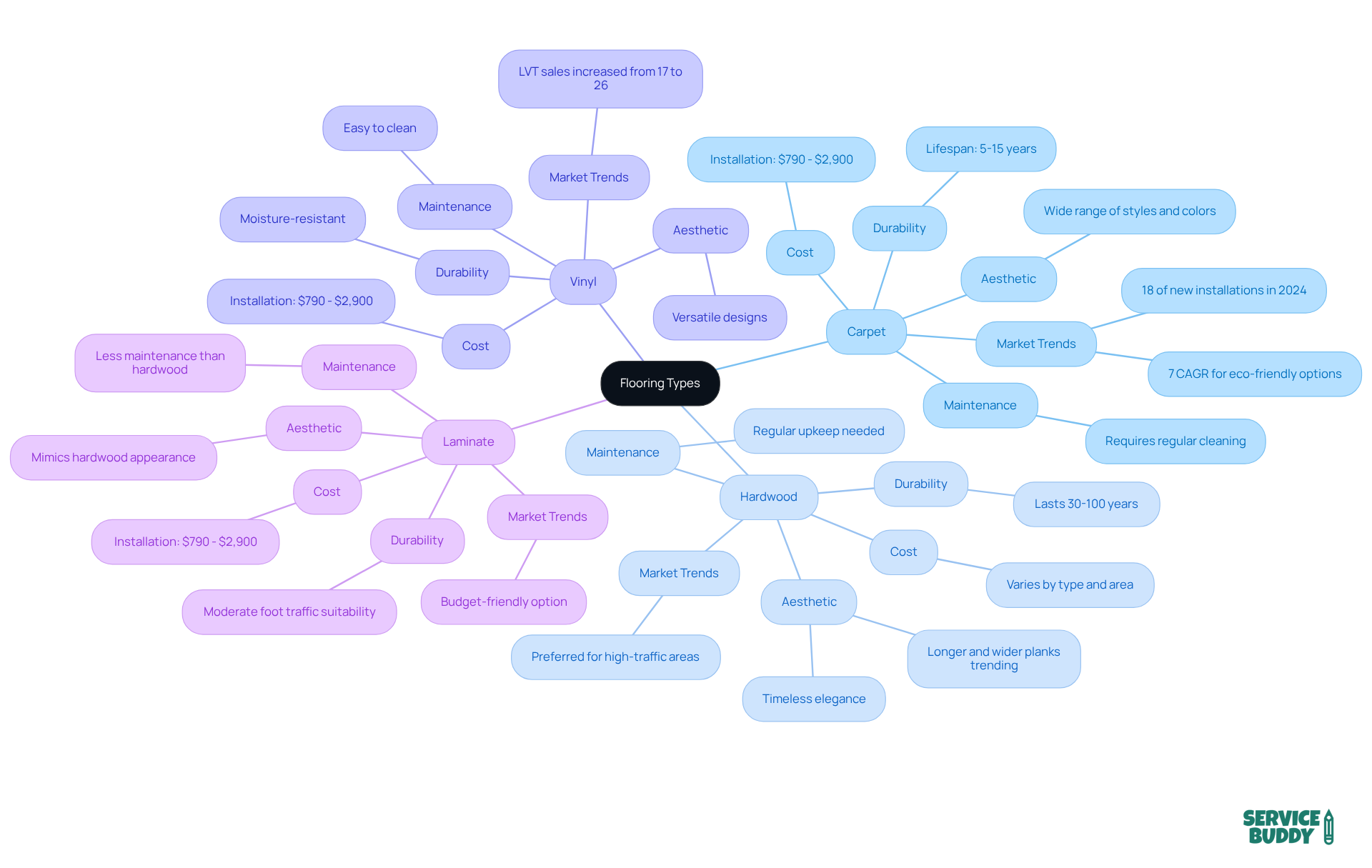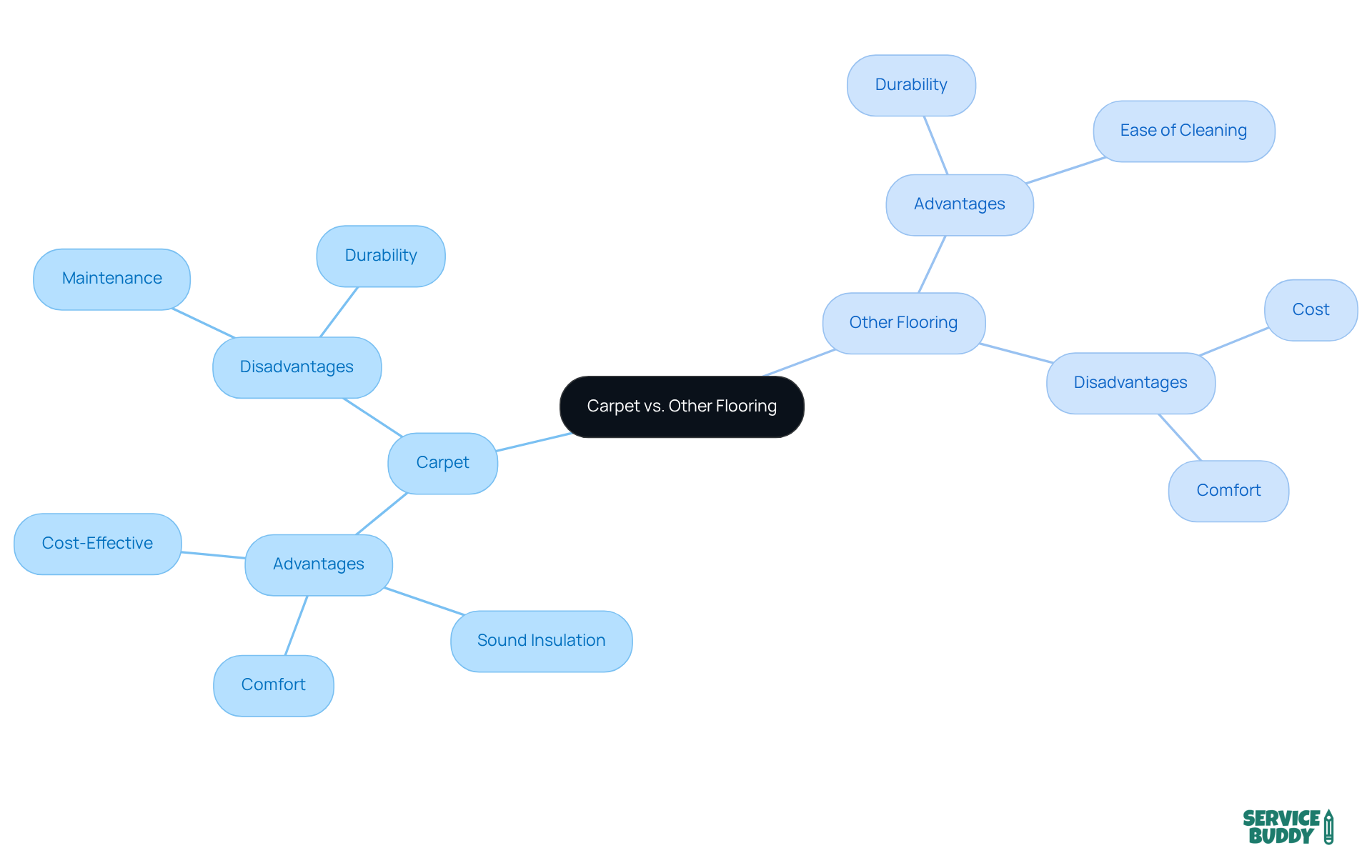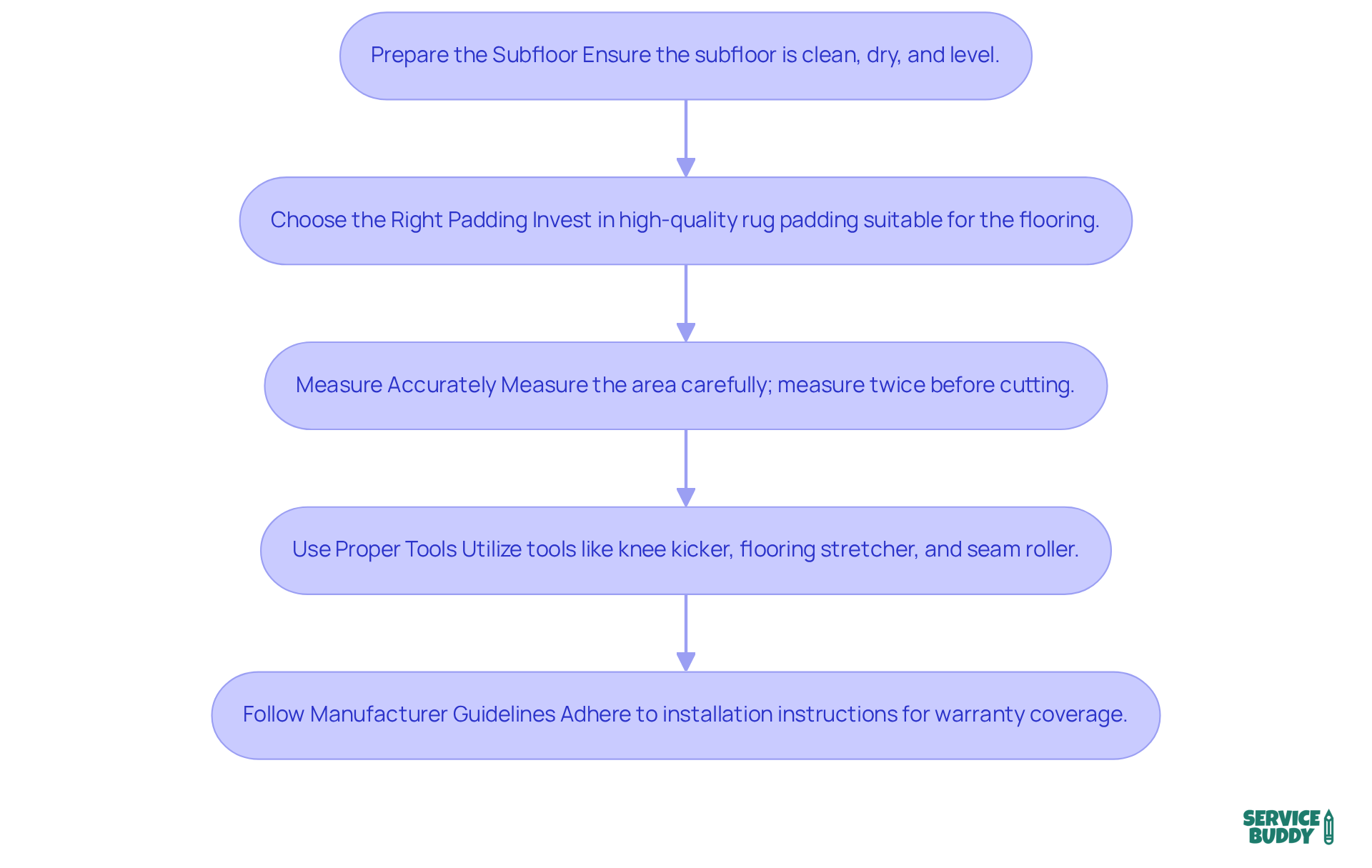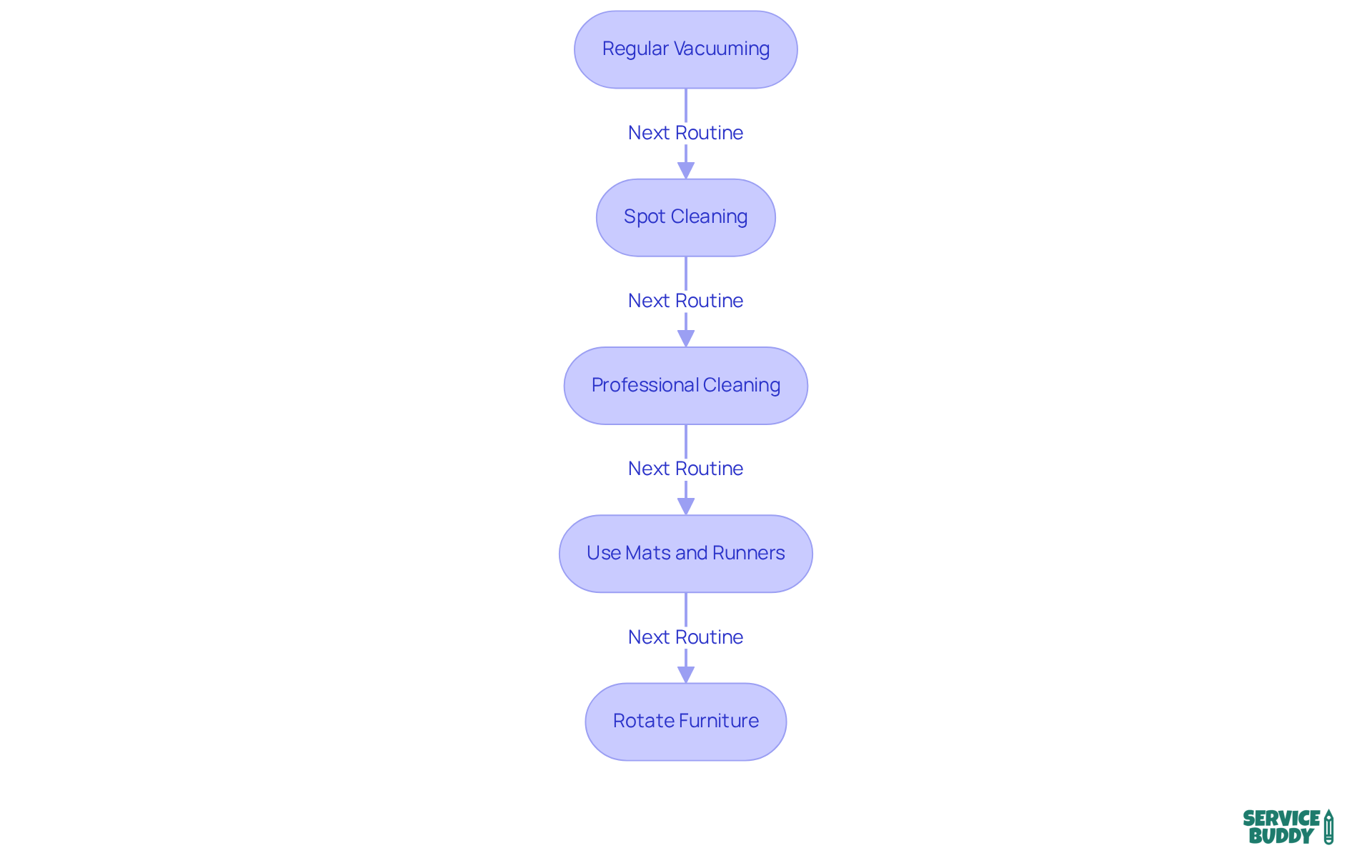Overview
This article highlights best practices for carpet and flooring, aimed at enhancing business efficiency. It serves as a guide for professionals in selecting and maintaining flooring options. Understanding various flooring types is crucial; it lays the foundation for effective installation techniques that can significantly impact client satisfaction.
Establishing maintenance routines is equally important, as they foster repeat business and contribute to operational success in the flooring industry. By implementing these strategies, flooring professionals can not only meet but exceed client expectations, ensuring long-term success.
Introduction
The realm of carpet and flooring transcends mere aesthetics; it embodies a complex interplay of durability, maintenance, and cost that can profoundly influence business efficiency. As the market continues to evolve, grasping the nuances of diverse flooring options—from the inviting warmth of carpet to the sophisticated elegance of hardwood—becomes imperative for professionals striving to meet varied client needs.
Yet, with an abundance of choices at their disposal, how can businesses adeptly navigate these waters to ensure they deliver optimal solutions while cultivating customer loyalty? This article explores best practices for:
- Selecting carpets and flooring
- Installing carpets and flooring
- Maintaining carpets and flooring
Providing insights designed to enhance operational effectiveness and elevate client satisfaction.
Evaluate Different Carpet and Flooring Types
When assessing different types of carpet and flooring, several key factors warrant consideration: durability, maintenance needs, aesthetic attractiveness, and cost. The most popular options include:
- Carpet: Renowned for its comfort and warmth, carpet is particularly suited for residential spaces such as bedrooms and living areas. It offers a wide range of styles, colors, and textures, allowing for extensive customization. Carpet represented almost 18% of all new surface installation projects in 2024, underscoring its enduring appeal. According to Baylee Bunce, the carpet and flooring market also shows growing popularity in eco-conscious and recycled materials, with an expected 7% compound annual growth rate (CAGR) between 2023 and 2033.
- Hardwood: This surface exudes timeless elegance and exceptional durability, making it ideal for high-traffic areas. However, it necessitates regular maintenance to prevent scratches and water damage. Current trends in hardwood are shifting towards longer and wider planks, appealing to modern aesthetics. As noted by industry experts, hardwood is a preferred choice for its longevity and aesthetic appeal, yet it requires a commitment to upkeep.
- Vinyl: A cost-effective and versatile option, vinyl is moisture-resistant and easy to clean, making it an excellent choice for kitchens and bathrooms. In 2023, luxury vinyl tile (LVT) sales surged from 17% to 26%, indicating a growing preference for this material. The typical expense for vinyl installation ranges from $790 to $2,900, depending on the size of the space and materials utilized.
- Laminate: Designed to mimic the look of hardwood at a more affordable price, laminate is suited for areas with moderate foot traffic but may not offer the same durability as hardwood. The average expense of laminate installation also varies from $790 to $2,900, based on area size and materials used.
By comprehending these choices, surface specialists can effectively assist their clients in selecting the appropriate material to meet their specific needs and tastes. This informed approach not only enhances client satisfaction but also fosters repeat business, as customers value that align with their lifestyle and budget.

Assess Advantages and Disadvantages of Carpet vs. Other Flooring
When comparing carpet and flooring to other types, it is essential to consider both the advantages and disadvantages to make informed decisions.
Advantages of Carpet:
- Comfort: Carpet offers a soft, warm surface that is inviting, making it an excellent choice for homes with children and pets.
- Sound Insulation: It effectively reduces noise levels, which is particularly beneficial in multi-story homes.
- Cost-Effective: Generally, carpet has lower initial costs compared to hardwood or tile, making it an attractive option for budget-conscious homeowners.
Disadvantages of Carpet:
- Maintenance: Regular vacuuming and professional cleaning are necessary to maintain its appearance and hygiene, which can be a drawback for some.
- Durability: Carpet is more susceptible to staining and wear in high-traffic areas, leading to a shorter lifespan compared to hard surfaces.
Advantages of Other Flooring Types:
- Durability: Hardwood and tile can last for decades with proper care, representing a long-term investment for homeowners.
- Ease of Cleaning: Hard surfaces are typically easier to clean and maintain, especially in areas prone to spills, making them a practical choice.
Disadvantages of Other Flooring Types:
- Cost: The upfront costs for materials and installation are generally higher, which can be a significant consideration.
- Comfort: Hard surfaces can feel cold and uncomfortable underfoot, particularly during winter months.
By weighing these factors, flooring professionals can guide clients in making decisions regarding carpet and flooring that align with their lifestyles and budgets.

Implement Best Practices for Carpet Installation
To ensure a successful carpet installation, it is essential to follow these best practices:
- Prepare the Subfloor: Start by ensuring the subfloor is clean, dry, and level. Any imperfections can lead to significant issues with the flooring's appearance and longevity.
- Choose the Right Padding: Invest in high-quality rug padding to enhance comfort and extend the rug's lifespan. The padding should be suitable for the type of flooring being installed.
- Measure Accurately: Measure the area carefully to avoid waste and ensure a proper fit. Always measure twice before cutting to guarantee precision.
- Use Proper Tools: Utilize the right instruments, including a knee kicker, flooring stretcher, and seam roller, to achieve a quality finish that meets industry standards.
- Follow Manufacturer Guidelines: Adhere to the manufacturer's installation instructions for specific products to ensure warranty coverage and optimal performance.
By adhering to these best practices, flooring specialists can provide high-quality installations that not only satisfy client expectations but also enhance their reputation in the industry. This commitment to excellence is crucial for overcoming operational challenges and achieving long-term success.

Establish Effective Maintenance Routines for Longevity
To effectively maintain carpets and extend their lifespan, flooring professionals should encourage clients to adopt the following maintenance routines:
- Regular Vacuuming: Vacuuming at least once a week is essential to remove dirt and debris that can damage carpet fibers. In high-traffic areas, more frequent cleaning may be necessary to prevent buildup.
- Spot Cleaning: Address spills immediately using appropriate cleaning solutions to prevent stains from setting. Employ a blotting technique rather than scrubbing to protect the integrity of the fibers.
- Professional Cleaning: Scheduling professional deep cleaning every 12 to 18 months is crucial for removing embedded dirt and allergens. This practice not only enhances the appearance of carpet and flooring but also significantly contributes to their longevity. Notably, floor covering cleaning as a separate service constitutes 25% of revenue for almost all companies surveyed, emphasizing its significance in the industry.
- Use Mats and Runners: Placing mats at entryways and runners in high-traffic areas can effectively reduce wear and tear on flooring, preserving its condition over time.
- Rotate Furniture: Periodically rearranging furniture helps prevent uneven wear, allowing rugs to maintain their aesthetic and functional qualities longer.
Implementing these maintenance routines can help clients keep their carpet and flooring looking new and extend their usability. This proactive approach not only enhances customer satisfaction but also aligns with industry insights, as many businesses face . Furthermore, about 30% of enterprises are still adversely affected by the lingering consequences of the COVID-19 pandemic, making it essential for specialists to cultivate lasting connections with clients through efficient maintenance strategies. By emphasizing the importance of regular maintenance, flooring professionals can drive business growth and ensure their clients' satisfaction.

Conclusion
Evaluating the best practices for carpet and flooring underscores the critical role of informed decision-making in boosting business efficiency. By comprehensively understanding the various types of flooring—such as carpet, hardwood, vinyl, and laminate—professionals can adeptly guide clients toward choices that best meet their needs. This expertise not only enhances client satisfaction but also cultivates loyalty, as customers value personalized recommendations that align with their lifestyle and budget.
Key insights include:
- The advantages and disadvantages of different flooring types
- The importance of proper installation practices
- The necessity of effective maintenance routines
Carpet is notable for its comfort and sound insulation, while hardwood and tile provide durability and ease of cleaning. Adhering to best practices during installation and maintenance can significantly influence the longevity of flooring, ultimately leading to improved business operations and client retention.
In today's competitive market, prioritizing these best practices is vital for flooring professionals seeking to thrive. By dedicating time to educate clients about flooring options and maintenance, businesses can foster enduring relationships that drive growth and success. Embracing these strategies not only addresses current industry challenges but also positions flooring specialists as trusted advisors in their field.
Frequently Asked Questions
What factors should be considered when evaluating different types of carpet and flooring?
Key factors to consider include durability, maintenance needs, aesthetic attractiveness, and cost.
What are the advantages of using carpet in residential spaces?
Carpet is known for its comfort and warmth, making it particularly suited for areas like bedrooms and living rooms. It also offers a wide range of styles, colors, and textures for customization.
What percentage of new surface installation projects in 2024 involved carpet?
Carpet represented almost 18% of all new surface installation projects in 2024.
What is the trend in the carpet and flooring market regarding eco-friendly materials?
There is a growing popularity in eco-conscious and recycled materials in the carpet and flooring market, with an expected 7% compound annual growth rate (CAGR) between 2023 and 2033.
What are the characteristics of hardwood flooring?
Hardwood flooring is known for its timeless elegance and exceptional durability, making it ideal for high-traffic areas. It requires regular maintenance to prevent scratches and water damage.
What current trends are observed in hardwood flooring?
Current trends in hardwood are shifting towards longer and wider planks, appealing to modern aesthetics.
What makes vinyl flooring a popular choice for kitchens and bathrooms?
Vinyl is a cost-effective, versatile option that is moisture-resistant and easy to clean, making it suitable for kitchens and bathrooms.
What was the sales trend for luxury vinyl tile (LVT) in 2023?
In 2023, luxury vinyl tile (LVT) sales increased from 17% to 26%, indicating a growing preference for this material.
What is the typical installation cost range for vinyl flooring?
The typical expense for vinyl installation ranges from $790 to $2,900, depending on the size of the space and materials used.
How does laminate flooring compare to hardwood in terms of cost and durability?
Laminate flooring mimics the look of hardwood at a more affordable price and is suited for areas with moderate foot traffic, but it may not offer the same durability as hardwood. The average installation cost for laminate also ranges from $790 to $2,900, based on area size and materials used.
How can surface specialists assist their clients in choosing flooring materials?
By understanding the various flooring options, surface specialists can provide tailored recommendations that align with clients' specific needs and tastes, enhancing client satisfaction and fostering repeat business.




